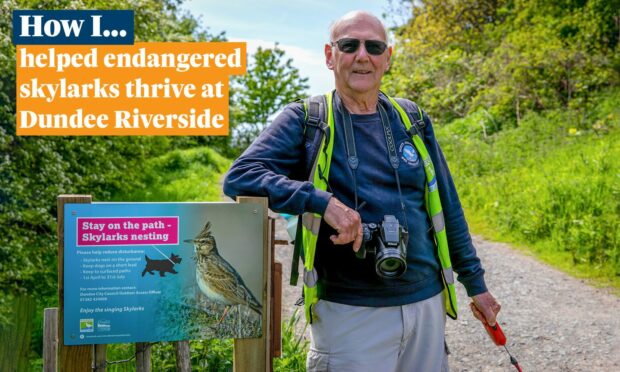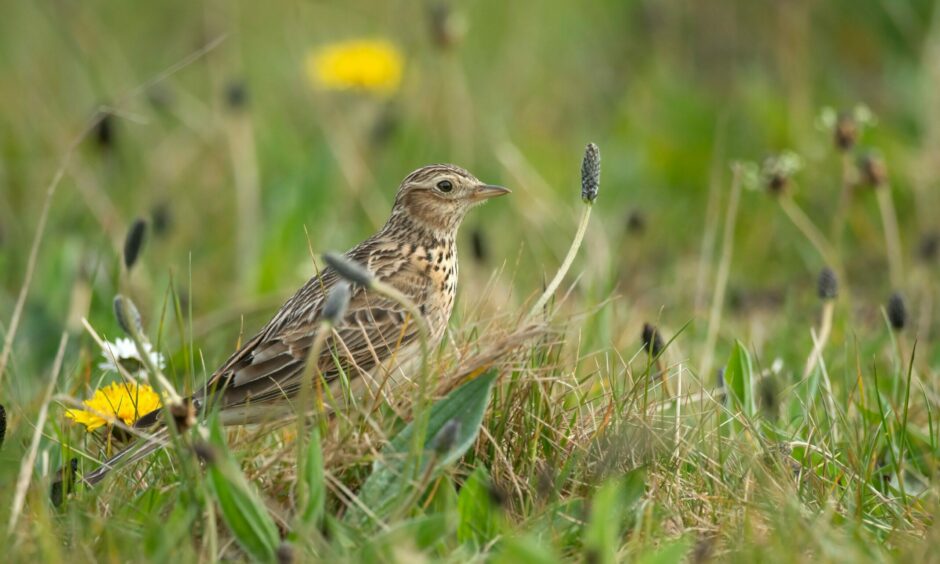Ian Ford has won awards for his biodiversity work at Dundee Riverside Nature Park.
He butted heads with council chiefs when grasscutters removed Great Yellow Rattle he planted.
That and other biodiversity work led to Ian and his colleagues at Friends of Riverside Nature Park (RNP) to be given a Green Flag award.
But that’s not what he’s most proud of at the beauty spot.
No, it’s allowing a small and endangered bird to flourish there.
The skylark.
Ian described them as having a cheeky “what are you looking at” swagger.
This is the story of his love of the beleaguered bird and his work to give them a chance to thrive in Dundee.
‘Iconic’ red-listed bird
As well as their strut, Ian said he admires skylarks because of their distinctive song and a flight that “rises to heaven”.
The ground-nesting bird has suffered a “drastic and dramatic” population decline.
Ian has been a lover of nature since childhood. When he became chairman of the Friends of Riverside Nature Park (RNP) when it formed in 2013, creating a home for the bird was one of his priorities.
He said: “When we started work in earnest to create a skylark habitat, there were three of them near Dundee Airport.
“They are migrating birds. They spend the winter in Spain or Italy and when they come back, it’s to roughly the same area.
“I thought if we could create a good habitat for them nearby at RNP, then if there was no space at the airport they wouldn’t have to go too far to find a home.”
And it appears his hunch was correct. Since then, skylark populations in the area have quintupled to 18 at last count.
It’s something Ian hopes will continue to grow.
Humble beginnings
Ian’s love of nature started at an early age.
“When I was a kid I would go out with my older brother who was a keen outdoorsman, so I sort of followed in his footsteps.”
After becoming involved in managing land and wildlife as a volunteer in his 30s, he spent decades “ranting into the air” that Dundee should be making better use of its green spaces.
This sometimes took the form of missives in the letters pages of The Courier.
When the opportunity to get involved at RNP came up in 2014, he jumped in with both feet.
Bringing skylarks to Dundee
To attract the small-crested bird to RNP, Ian and his team had to lay a lot of groundwork.
“It was important to adopt what’s known as the Cut and Lift method of grass cutting,” he explains.
This less intensive form of ground maintenance allows for wildflowers to flourish.
“That helps insect life, which itself in turn encourages animals that eat insects there, such as skylarks.”
Why are skylarks under threat?
While 18 birds is not a very high number it’s very much a case that every little helps.
A switch in farming methods is thought to have led to an estimated 75% fall in skylark population from 1972 to 1996.
Ian would like to see more skylarks at RNP, but they will have to find more space for them.
“Even with the 18 that were here last year, there were some of them outside the area we created with them in mind.
“That shows it is attractive to them, but there’s only so much space at Riverside so we’ll need to see what we can do.”
The importance of keeping dogs on leads
As skylarks are ground nesting, dogs can prove disastrous.
One common task for Ian is asking dog owners to keep their pets on a lead so they do not run into the grass and disturb the skylarks.
At best this would frighten them. At worst it could lead to dead skylarks.
But Ian stresses not all dog walkers are guilty of this.
“I would like to thank the dog owners who do keep the dogs on a lead and are considerate.
“One thing I’d like to do going forward is have more information signs so people understand what we’re doing here and why.”
A spiritual bird
Ian described skylarks as a “spiritual” bird.
“They have a very distinctive call and they are quite cheeky.
“When intimated, they puff up their chest and walk around as if they’re saying ‘what are you looking at?’
“So they are very characterful.”
Ian gets almost religious when talking about them.
“They are an iconic British bird and they need our help.
“The way they fly towards the sky from their nest is almost like they are flying to heaven.
“You don’t get that with many other birds.”












Conversation